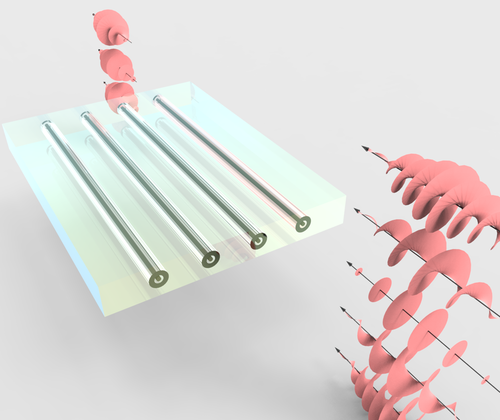Twisted Light in a Photonic Chip
A light beam with a corkscrew-shaped wave front can encode information based on the tightness and direction of the helix. This “twisted light” has potential uses in optical telecommunications and computing, but it is difficult to direct such light within chip-based photonic circuitry. A team in China has now demonstrated an optical waveguide that can carry twisted light efficiently on a chip and even “purify” its quantum state in the process.
Twisted light is characterized by an integer quantum number, , that indicates (in units of Planck’s constant ) the orbital angular momentum (OAM) of each photon. Positive and negative values of correspond to light twisted in opposite directions, like left- and right-handed corkscrews.
The possibilities for information technologies come from using these discrete quantum states to encode information, much as two-state quantum entities can act as quantum bits (qubits) encoding 1’s and 0’s. But for twisted light, can take any integer value, so beams can encode more information. For example, three optical modes with and can act as a “qutrit,” with three encoding states. In principle, well-defined modes up to approximately can be produced by photonic devices [1]. Such light can also be placed in quantum combinations (superpositions) of these states, which means that it can be used for optical quantum computing.
Twisted light has previously been generated by chip-based optical devices and emitted into free space [2–4]. But keeping such light in a chip and moving it around in waveguides has proven challenging. The problem is that ordinary, fiber-optic-style channels won’t support “pure” OAM modes, in effect blurring any information encoded in them. Xian-Min Jin and co-workers from Shanghai Jiao Tong University have now made a new kind of waveguide that allows such modes to propagate cleanly.
The key is to vary the waveguide’s refractive index in a “doughnut” pattern, as seen in cross section—lower index in the core and higher index in the surrounding ring. This principle has been known for some time [5]; the difficulty is in making such structures. “The conventional fabrication methods are unable to produce the necessary, arbitrary, three-dimensional structure,” says Jin.
The researchers used a laser-writing method in which ultrashort (few-hundred-femtosecond) pulses of green light are focused at a precisely controlled shallow depth within a borosilicate glass wafer. Absorption of the light locally transforms the transparent material and modifies its refractive index, while the shortness of the pulses ensures that the change is highly localized. The doughnut cross section was produced by fabricating 12 separate but overlapping, narrow, high-index channels arranged in a ring around the low-index core to generate a continuous cylindrical channel. In some of the waveguides, the team added an additional high-index central channel within the low-index core to improve the transmission.
The resulting waveguides were about 10 micrometers in diameter and almost 20 mm long. Jin and colleagues tested them with twisted light having and superpositions of those three states. They measured the intensity profiles of the beams entering and exiting the waveguides, as well as the interference between the transmitted beam and a reference beam identical to the input beam that was sent through free space. This interference revealed the helicity of the beams.
These measurements showed that the waveguides can support twisted modes and can also filter out “impure” components, leaving only photons with well-defined values of . There was some loss of intensity within a waveguide, but the exiting beam was still 60% as bright as the input. The losses were greater still for higher values of , but Jin says that his team is developing waveguides better suited to carrying these higher-order modes. The waveguides were also able to faithfully transmit twisted light that was so dim that just one photon at a time was sent through.
“This chip for transmitting twisted light is a significant advance, which may find applications in future on-chip optical and quantum computing,” says Haoran Ren, who works on chip-based optical technologies at RMIT University in Australia.
Jin says he hopes to see the first applications in high-capacity optical communications. But Kishan Dholakia, a specialist in optical manipulation at the University of St. Andrews, UK, warns that there is still some debate about whether twisted light can deliver on its promise of high data density [6]. However, he thinks this new chip design could potentially open up applications in quantum photonics and imaging.
This research is published in Physical Review Letters.
–Philip Ball
Philip Ball is a freelance science writer in London. His latest book is How Life Works (Picador, 2024).
References
- R. Fickler, R. Lapkiewicz, W. Plick, M. Krenn, C. Schaeff, S. Ramelow, and A. Zeilinger, “Quantum entanglement of high angular momenta,” Science 338, 640 (2012).
- C. R. Doerr, N. K. Fontaine, M. Hirano, T. Sasaki, L. L. Buhl, and P. J. Winzer, “Silicon photonic integrated circuit for coupling to a ring-core multimode fiber for space-division multiplexing,” Proceedings 37th European Conference and Exposition on Optical Communications, Geneva, 2011, paper Th.13.A.3 (Optical Society of America, 2011).
- X. Cai, J. Wang, M. Strain, B. Johnson-Morris, J. Zhu, M. Sorel, J. O, M. G. Thompson, and S. Yu, “Integrated compact optical vortex beam emitters,” Science 338, 363 (2012).
- J. Sun, M. Moresco, G. Leake, D. Coolbaugh, and M. Watts, “Generating and identifying optical orbital angular momentum with silicon photonic circuits,” Opt. Lett. 39, 5977 (2014).
- S. Ramachandran and P. Kristensen, “Optical vortices in fiber,” Nanophotonics 2, 455 (2013).
- D. Miller, “Better choices than optical angular momentum multiplexing for communications,” Proc. Natl. Acad. Sci. U.S.A 114, E9755 (2017).







